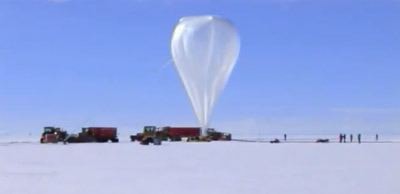The Surrey Museum brought a frigid science adventure to Cloverdale to help cool down a recent summer day.
The museum hosted UBC physicist and cosmology researcher Gaelen Marsden on July 23 as he regaled a group of 35 attendees with his tales of launching a balloon-borne telescope in Antarctica.
Marsden, who hails from Langley, said he had a great time presenting his work at the museum to an enthusiastic audience.
“I think it’s important for people to be exposed to science and know what scientists are trying to do,” he said.
“It’s fun for me to get excited and see other people get excited.”
Nearly 20 scientists from nine different universities worked alongside Marsden on the Balloon-borne Large-Aperture Submillimetre Telescope (BLAST), which measured infrared radiation (essentially heat signatures) from the edge of the visible universe.
 The project began with an initial proposal in 1999, followed by a test flight in 2005 down in the U.S. and a failed flight one year later in Sweden.
The project began with an initial proposal in 1999, followed by a test flight in 2005 down in the U.S. and a failed flight one year later in Sweden.
Marsden said the research conducted with BLAST added a piece to the overall picture of the universe, with the data suggesting that galaxies in the distant past were much more fertile than our own Milky Way today, which sees roughly one star birth per year.
“We’ve actually had about 40 papers come out of this, which is a lot,” he said.
Marsden told the audience about travelling to Antarctica to launch BLAST one last time at McMurdo Station in 2008, with a documentary crew in tow to record the adventure.
The launch was successful, but the landing was an exercise in tension. The balloon carried the telescope, which was the size of a small car, to a height of 41 kilometres for an 11-day flight that circled the South Pole.
When BLAST came down, the parachute refused to let go and the telescope was dragged across the Antarctic wastes for 200 kilometres.
The device was heavily damaged, but the crew managed to locate the data recorder, which contained the culmination of nine years of work.
Fortunately, the data was recovered and the documentary crew came away from the trip with a dramatic science adventure: BLAST! The Movie.
Marsden also discussed his current work on the Herschel space telescope project. Like BLAST, Herschel will look for infrared evidence of galaxies billions of light years away, but Marsden says the new device – launched in 2009 – will provide a better picture of the early universe because it has a higher resolution telescope on board.
For more information on the BLAST project, Marsden recommends checking out the trailer for the documentary.
The trailer is available at www.blastthemovie.com.
Follow the Cloverdale Reporter on  Twitter and
Twitter and ![]() Facebook. View our print edition online.
Facebook. View our print edition online.
